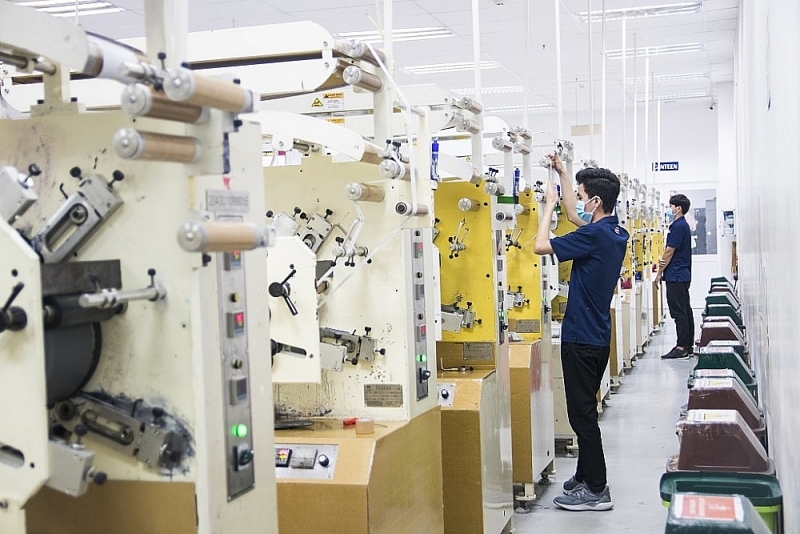3 years of EVFTA implementation accessed: significant room remains for Vietnam to capitalize
Having officially taken effect on August 1, 2020, the EU-Vietnam Free Trade Agreement (EVFTA) marked a pivotal milestone in the 30-year history of cooperation and development between the two sides. After 3 years of implementation, EVFTA has not only aided Vietnam in boosting exports and attracting European investment, but also stimulated institutional reforms domestically.
 |
|
EVFTA has also helped Vietnam increase imports of machinery, equipment and modern technology, contributing to the country's industrialization and modernization process. Photo: Thu Diu. |
It is not enough to change the production-export structure
Speaking at a seminar announcing the report “Evaluating 3 Years of EVFTA Implementation on Vietnam’s Economy,” part of the Macroeconomic Reforms/Green Growth Program funded by the German Federal Ministry for Economic Cooperation and Development through the German Agency for International Cooperation (GIZ), Dr. Tran Thi Hong Minh, Director of the Central Institute for Economic Management (CIEM), stated that as a new generation FTA, EVFTA has instituted sufficiently high standards to facilitate Vietnam’s economic institutional reform across numerous sectors like sustainable development, intellectual property, and public procurement. Alongside EVFTA, Vietnam has implemented a suite of FTAs, including other cutting-edge agreements. However, government agencies and academics have continually highlighted EVFTA’s ‘novelty,’ as Vietnam’s inaugural FTA with the EU, while underscoring the complementary rather than competitive nature of the two sides’ export structures, the CIEM Director elaborated.
The EU has remained a vital partner for Vietnam across many decades. On July 17, 1995, the two sides signed the Framework Cooperation Agreement (FCA), succeeded by the Comprehensive Partnership and Cooperation Agreement (PCA). Parallel to decades of cooperation were efforts to expand collaboration on trade, investment, tourism, and official development assistance. Against this backdrop, expectations for EVFTA were wholly understandable. Lessons from implementing preceding FTAs sufficiently demonstrated that ratifying EVFTA was just a prerequisite; realizing its benefits necessitated considerable exertion by Vietnam.
Presenting research findings evaluating EVFTA’s 3-year impacts on Vietnam’s economy, Mr. Nguyen Anh Duong, Head of CIEM’s Synthesis Research Department, said EVFTA helped facilitate Vietnam’s robust export recovery into the EU market, especially in the first 2 years. Its influence on EU-bound exports in year 3 was less favorable, partly owing to the global economy and EU’s specific challenges from myriad factors (political conflicts; Russia-Ukraine war; rising commodity prices and inflationary pressures; interest rate hikes and stricter import regulations in the EU market, etc.).
Moreover, EVFTA has enabled Vietnam to increase imports of machinery, equipment and cutting-edge technology, expediting the country’s industrialization and modernization, elevating product standards, enhancing integration into global value chains, and improving the international competitiveness of Vietnamese goods. Vietnam’s exports broadly demonstrated a superior ability to satisfy EU import demand right after EVFTA entered force. However, from 2017-2021 the EU export structure still trended toward reduced high-tech products. Export activity into this market remains below expectations, signaling immense untapped potential for expanding EU-bound exports.
What must be done to maximize benefits?
Regarding foreign direct investment (FDI), EVFTA’s influence on capital flows from the EU to Vietnam equally demonstrated tangible improvements in Vietnam’s overall FDI attraction outcomes. With plentiful tariff incentives and eliminated market access barriers across many sectors, EVFTA opened the door for EU investors to enter and expand investments in Vietnam. Despite the considerable impact of the 2020 COVID-19 outbreak, EU investment in Vietnam more or less increased post-pandemic. The Netherlands, France, Luxembourg, Germany, Denmark and Belgium respectively rank as the top 6 EU investors in Vietnam. The proportion of registered capital from EU investors rose from around 5% of total registered capital on average from 2016-2020 to 8.9% in 2022 and 9.2% in the first half of 2023.
Additionally, according to Mr. Nguyen Anh Duong, EVFTA has promoted institutional reform. Analysis shows that areas including trade, investment, intellectual property, sustainable development, financial services and public procurement have all undergone considerable institutional adjustments, with Vietnam’s legal framework now largely aligned with EVFTA commitments. Moreover, progress in preparing certain legal documents to implement EVFTA was slightly swifter compared to CPTPP, potentially owing to lessons learned from CPTPP implementation. However, Vietnam should contemplate its approach to particular commitments across some sectors, avoiding excessively rigid domestic legislation that could undermine domestic market adaptability to new developments.
According to Mr. Dennis Quennet, advisor to the Macroeconomic Reforms/Green Growth Program, EVFTA has impacted all facets of the economy from the state level to individual agencies, propelling Vietnam’s green economy.
To maximize EVFTA benefits amid Vietnam’s economic institutional reform and international integration, the CIEM Synthesis Research Department Head stated that reviewing and improving regulations and legal documents during implementation is necessary to ensure full, consistent commitment implementation. This includes considering higher policy adjustments beyond commitments when truly essential and fitting to the new landscape.
Concurrently, efforts must be made to improve the investment and business environments, strengthen enterprise and whole-economy competitiveness, and enhance and innovate trade promotion activities to capitalize on EVFTA opportunities.








